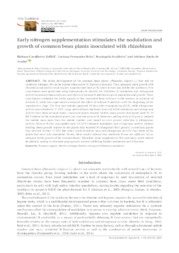Early nitrogen supplementation stimulates the nodulation and growth of common bean plants inoculated with rhizobium.
Early nitrogen supplementation stimulates the nodulation and growth of common bean plants inoculated with rhizobium.
Summary: The initial development of common bean plants (Phaseolus vulgaris L.) relying on symbiotic nitrogen (N) can be limited by delayed active N2 fixation, requiring supplemental N which in turn may inhibit the symbiosis. Five experiments were carried out in hydroponics to identify the initiation of nodulation and nitrogenase activity in common bean cultivars, and the effects of additions of mineral N on plant nodulation and growth. Three experiments evaluated the initial growth of five inoculated bean cultivars in the absence or presence of mineral N, and two experiments evaluated the effect of the moment of mineral N addition until the beginning of reproductive stage. The first root nodules appeared 10 days after plant transplant (DAT) and nitrogenase activity initiated 11 DAT. Cultivars of large seeds had lower initial nodulation and nitrogenase activity than those of small seeds. Inoculated plants showed limited shoot growth that lasted until 21-25 DAT as compared to inoculated plants receiving mineral N. Addition of mineral N reduced nodule mass more intensively than nodule number and more strongly nitrogenase activity. Nitrogen applied until 15 DAT enhanced nodulation and nitrogenase activity without limiting shoot growth, as compared to plants receiving N throughout their growth. Otherwise, plants that received N after 15 DAT had lower nodule mass and nitrogenase activity than plants only inoculated. The results indicate that symbiotic N did not suffice to an adequate growth of common beans and some supplemental N is necessary. This N should be added in the beginning of growth cycle to stimulate plant growth without inhibiting further nodulation and N fixation.
Publication year: 2021
Types of publication: Journal article
Unit: Embrapa Soils
Observation
Some of Embrapa's publications are published as ePub files. To read them, use or download one of the following free software options to your computer or mobile device. Android: Google Play Books; IOS: iBooks; Windows and Linux: Calibre.
Access other publications
Access the Agricultural Research Database (BDPA) to consult Embrapa's full library collection and records.
Visit Embrapa Bookstore to purchase books and other publications sold by Embrapa.

